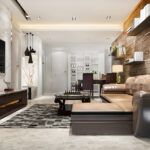Interior design trends come and go, but good design, the kind that makes a space feel effortless, refined, and deeply personal, relies on a few enduring principles. Whether you’re designing a modern retreat, a coastal escape, or a traditional family home, these core ideas continue to shape beautiful interiors year after year.
For homeowners seeking thoughtful interior design in West Palm Beach, starting with the basics isn’t about playing it safe; it’s about building a timeless foundation. And from that foundation, every detail—fabric, texture, proportion—has the space to shine.
Let’s take a closer look at the principles that continue to guide great interiors, no matter the aesthetic.

1. Function Before Form
The most elegant spaces are also the most livable. That’s not a coincidence.
Before selecting paint colors or drapery fabric, great design starts with understanding how a space will be used. Is it for entertaining? Resting? Working? The layout and design decisions must serve that purpose.
- A reading nook should invite stillness and soft light.
- A family room should accommodate comfort and conversation.
- A dining area should support movement, gathering, and the occasional celebratory spill.
Every choice, from furniture placement to lighting, should support the daily rhythm of the space. Style enhances function; it doesn’t override it.
2. Create Balance and Flow
Rooms feel balanced when the visual weight is distributed thoughtfully. This doesn’t mean everything has to be symmetrical. In fact, asymmetry, when done well, can bring energy to a space.
But too many heavy elements (dark colors, oversized furniture, busy patterns) in one area can make a room feel off-kilter. The eye should move comfortably across the space, guided by thoughtful spacing, alignment, and rhythm.
Pay attention to negative space as well—those areas of calm between focal points. They give the room room to breathe.
3. Layer with Purpose
Layering is the quiet hallmark of sophisticated design. It’s what turns a room from visually pleasing to emotionally inviting.
Start with structure: the layout, architectural details, and foundational furniture pieces. Then add texture: think soft textiles, woven accents, smooth stone, and natural wood. Follow with color, artwork, and lighting that complement (not compete with) the palette.
Layering isn’t about abundance. It’s about intention. One well-placed velvet pillow can elevate an entire sofa. A curated gallery wall can echo the tones of a nearby rug. Less, in this context, becomes more meaningful.

4. Pay Attention to Scale and Proportion
Even the most beautifully designed furniture can feel wrong in a space if it’s not scaled correctly.
- A petite chandelier in a grand entryway will look lost.
- An oversized sectional in a compact living room will dominate and overwhelm.
Design harmony depends on proportion. This means considering not just the individual pieces but also how they relate to the room’s architecture and to one another.
Using tools like floor plans, painter’s tape outlines, or scaled drawings helps ensure selections make sense spatially before anything is purchased or placed.
5. Honor Light—Both Natural and Artificial
Light shapes how we see color, texture, and space. It defines the mood of a room.
Start by considering natural light. How does it enter the space? Morning light is cool and crisp; afternoon light is warmer and golden. These shifts affect wall colors, wood tones, and reflective surfaces throughout the day.
Then layer artificial lighting accordingly. Every room benefits from three types:
- Ambient lighting for overall illumination
- Task lighting for focused activities (reading, cooking, grooming)
- Accent lighting to highlight architectural features or art
Dimmers, lampshades, and warm-toned bulbs all play a part in creating the right atmosphere.
6. Let Color Support the Emotion
Color is deeply personal. Some homeowners gravitate toward calming neutrals, while others feel energized by saturated tones. There’s no universal palette, but there are universal effects.
Soft blues and warm greys promote calm. Earthy greens and muted rusts connect us to nature. High-contrast combinations, like black and white, bring a sense of clarity and drama.
When selecting a palette, start with the feeling you want to create. From there, limit the main color story to two or three hues. Accent colors can evolve seasonally or with accessories, but the core palette should feel cohesive across rooms.
7. Texture is Non-negotiable
A neutral room with the right mix of textures can feel more dynamic than a colorful room without them.
In West Palm Beach homes, where light and air are part of the experience, texture does more than add visual interest—it introduces depth and dimension.
Mix soft with structured, matte with sheen, smooth with tactile. A linen curtain against a painted wall. A woven chair beside a glass table. These contrasts make the room feel lived-in and layered, not flat or one-note.
8. Don’t Overfill the Room
The instinct to fill every corner is common. But restraint is often what gives a space presence.
Leaving room around furniture, art, and accents gives those elements more importance. It also allows the architecture of the home to breathe.
Think of each room as a curated conversation. Too many voices competing can overwhelm; the right amount, spaced thoughtfully, creates clarity and comfort.
9. Embrace Timeless Over Trendy
Trends can inspire, but the best designs outlast them. A well-made sofa with classic lines. Tailored drapes in natural fiber. A color palette that reflects the light and landscape around you. These choices never feel dated.
That doesn’t mean avoiding personality, quite the opposite. But let the architectural bones and investment pieces feel timeless. Then add trendy elements through art, cushions, or accessories that can shift with your taste.
10. Let Your Home Reflect You
The most compelling interiors don’t follow a single style rulebook—they reflect the people who live in them.
Incorporate meaningful objects, such as travel finds, heirloom pieces, or custom elements created just for your space. These items bring authenticity and warmth that can’t be purchased in a showroom.
Good design is personal. It doesn’t shout. It tells a story—your story—through careful, considered details.
Why the Basics Still Matter
Interior design is often considered the final layer, but it’s far more foundational than that. It shapes how a home feels—how we move, rest, host, and connect.
For homeowners in West Palm Beach and beyond, grounding a design in these enduring principles creates a home that feels calm, cohesive, and deeply lived-in. And whether the aesthetic is modern coastal, traditional, or transitional, starting with the basics never steers you wrong.

Bring Your Vision to Life with Expert Interior Design in West Palm Beach
If you’re seeking refined, personalized interior design in West Palm Beach, Mayfair’s team is here to help. At Mayfair Workroom, we bring the design process directly to your home, curating fabric, furnishing, and finish selections that honor your space and your style. Schedule your in-home consultation today and experience what thoughtful design can do.




